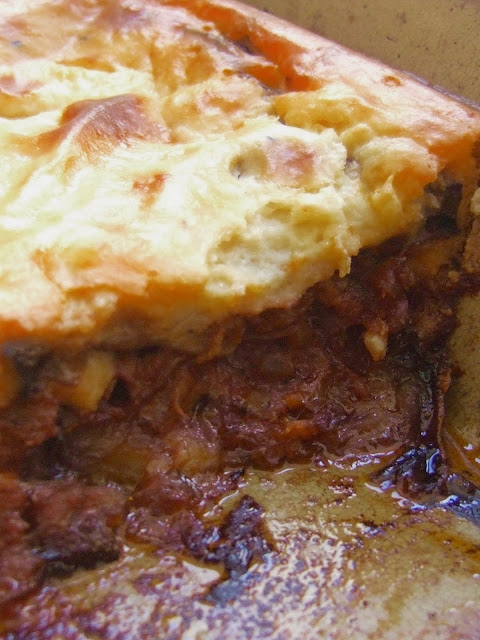Achilles' meal
If you're a food writer, and you're writing about food that exudes fat or oil, you have to use the word unctuous or unctuousness whether you understand what it means or not. Ironically, another meaning for the adjective is, "Characterized by affected, exaggerated, or insincere earnestness."
Easter is over and its back to finding ideas for fulfilling weekday suppers.Moussaka seems the perfect choice for this time of year, like a parmigiana; a dish which simultaneously manages to
taste of sunshine, and boast the warming qualities of cinnamon and allspice, sufficient to bring you in from the cold wind and unexpected spring shower.Funny that having just had an exceptional leg of new season Alentejan lamb for Easter and over purchased on aubergines for a pre-Easter catering job which involved individual parmigiana starters, all was in place for eating fresh products in the right season. Eyebrows might be raised at the mention of leftover lamb, but I am sure that a lot of us have found ourselves left with a plethora of the stuff Easter dinner was made of. Moussaka is generally made with fresh mince, like a rather superior sort of shepherd's pie, but reading between the lines, both dishes can be immeasurably improved by using meat that has already been cooked and I am sure that is how they were first made. My mother used to have a little hand mincer that was permanently clamped on to the end of the kitchen work table: the point of it was not to do as Mrs Lovatt did in Sweeney Todd ( a little home butchery) but to grind up the remains of the former roast for recycling into a shepherd's pie or a Moussaka.
Lamb leftovers are slightly trickier to use up than beef or chicken. The meat is very fatty, which makes it unctuous and flavoursome when hot, but too greasy to nibble as a cold snack or use in sandwiches and salads.Instead, your best bet is to recook it and turn it into something new.
If I was a Masterchef contestant,(which I was once) for my calling card,in which the amateur chefs are asked to cook up a dish that’ll make Gregg use the phrase “nice plate of food”. I would cook a cracking Moussaka.
Mousaka incorporates some essential basic techniques, such as making a good meat ragout and learning how to make a good white sauce,there is even a bit of knife work with vegetables and also a bit of egg cookery, all of which should excite the novice cook and Gregg to boot
Even to an old hand, it is a dish that gives huge satisfaction to make. It is one of those composite dishes, like cassoulet or a navarin of lamb, in which the coming together of two or three ingredients produces something transcendent and unique. Alchemy is afoot in the transformation of a couple of aubergines, a bit of old roast lamb and a white sauce into something so aromatic and satisfying.
Serves 6
Although I have specified cooked meat in this recipe, raw lamb mince would be fine. But fry it well in a little olive oil before adding it to the softened onion - and extend the cooking time by 20 minutes.
2 onions
olive oil
1 tbsp tomato purée
1 cinnamon stick
1/2 tsp allspice
1 dsp dried oregano or 1 tbsp fresh
250ml (9fl oz) stock or gravy from the roast
3 large aubergines
50g (2oz) flour
300ml (10fl oz) milk
2 bay leaves
generous pinch of nutmeg
half an onion
6 cloves
200g (7oz) Greek yoghurt
75g (3oz) feta cheese, finely grated
25g (1oz) parmesan, finely grated
2 egg yolks
Slice the aubergines crossways into 7mm (1/3in) slices.Drag these through some flour and fry them in olive oil until golden brown on both sides (alternatively brush the aubergines lightly with oil and grill them in a dry griddle pan). Once cooked, drain the aubergines well.
To make the topping, melt the butter in a small but heavy saucepan and add the flour. Stir well over a gentle heat for a couple of minutes until it acquires a sandy consistency then add two or three tablespoons of the milk. Work this to a smooth paste with a wooden spoon and then pour in the rest of the milk. Whisk this well as it comes to the boil. Add the bay leaves, the nutmeg and the onion studded with cloves. Simmer the white sauce gently for 20 minutes. Whisk together the yoghurt, the feta, the parmesan and the egg yolks in a bowl. Once the white sauce is cooked, pour it through a strainer into the yoghurt mixture and whisk it together well. Allow it to cool.
Assemble the moussaka as follows. Cover the bottom of a large oven-proof dish or tray with a layer of aubergines and then with half the meat sauce and then with a second layer of aubergines. Repeat the process - a layer meat and aubergines - and then pour the white sauce over the top in a single thick layer. Bake the moussaka in a medium oven (200C/400F/gas mark 6) for 35 to 4o minutes,until bubbling brown around the sides and acquiring a golden crust on topThe dish is best served after it has been out of the oven for 20 minutes. A green salad is all you need to accompany the dish,but a tomato and onion salad would be even better.



Comments
Post a Comment